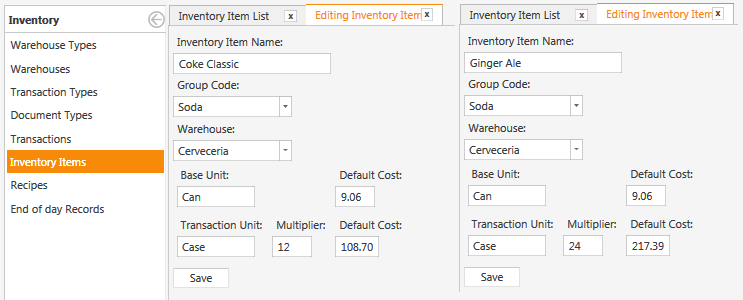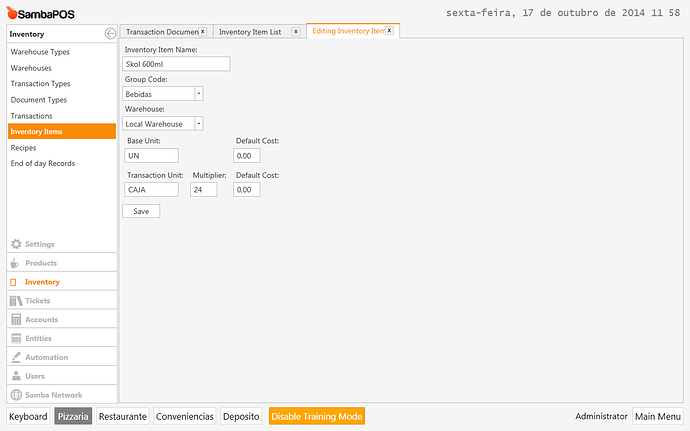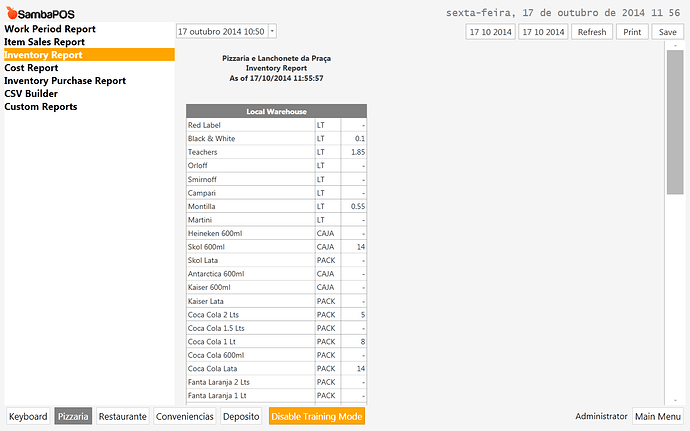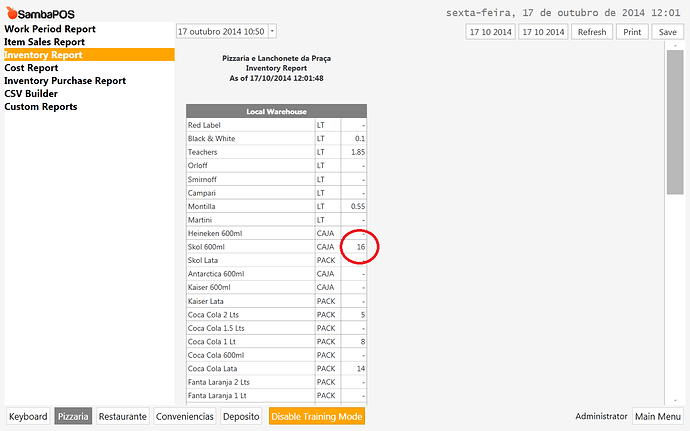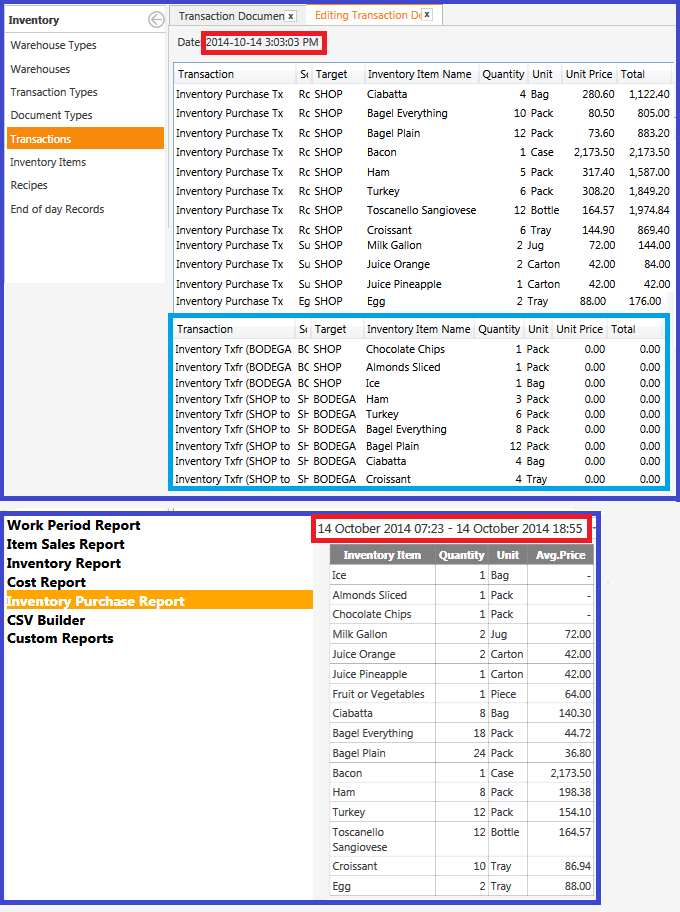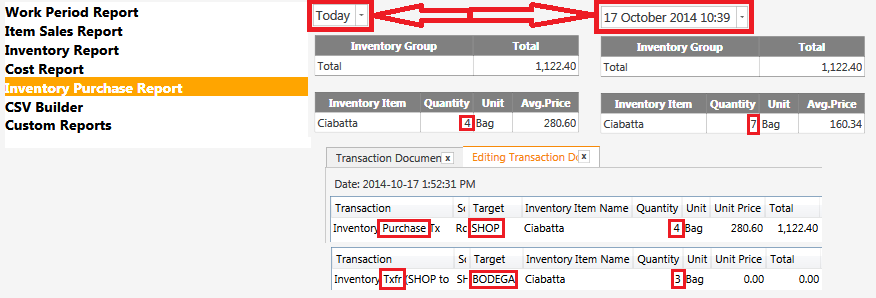I alreaady have two reports, one that shows your stock, and one that shows what items to buy.
The problem is that both work outside WORK PERIOD…
Stock:
SELECT [InventoryItemName],
CASE WHEN [BaseUnit] = [TransactionUnit] THEN
CONVERT(INT,ISNULL([PhysicalInventory],([InStock]+[Added]-[Removed]-[Consumption]))+
ISNULL((SELECT TOP 1 [Quantity] FROM [InventoryTransactions]
WHERE [InventoryItem_Id] = [PeriodicConsumptionItems].InventoryItemId AND [Date] >= CONVERT(varchar(10),GETDATE(),121)
ORDER BY [Id] DESC),0))
ELSE
CONVERT(INT,(CONVERT(numeric(6,2),ISNULL([PhysicalInventory],([InStock]+[Added]-[Removed]-[Consumption])))*[UnitMultiplier]))
END as Stockfisico,
[BaseUnit] as Unidad,
FORMAT(CONVERT(numeric(6,2),[Cost]),'C') as CostoUnit,
FORMAT(CONVERT(numeric(6,2),([Cost]*(ISNULL([PhysicalInventory],([InStock]+[Added]-[Removed]-[Consumption]))))
),'C') as CostoTOT
FROM [PeriodicConsumptionItems]
LEFT OUTER JOIN [InventoryItems] ON [InventoryItemId] = [InventoryItems].[Id]
WHERE [PeriodicConsumptionId] = (SELECT TOP 1 [Id] FROM [PeriodicConsumptions] ORDER BY [Id] DESC)
AND
CONVERT(numeric(6,2),ISNULL([PhysicalInventory],([InStock]+[Added]-[Removed]-[Consumption]))) >= 0.05
ORDER BY [InventoryItemName]
if you want (as I do) to have a estimate total money in stock:
SELECT FORMAT(SUM(CONVERT(numeric(6,2),CONVERT(numeric(6,2),([Cost]*(CONVERT(numeric(6,2),ISNULL([PhysicalInventory],([InStock]+[Added]-[Removed]-[Consumption])))))))),'C') as Costo
FROM [PeriodicConsumptionItems]
WHERE [PeriodicConsumptionId] = (SELECT TOP 1 [Id] FROM [PeriodicConsumptions] ORDER BY [Id] DESC)
AND
CONVERT(numeric(6,2),ISNULL([PhysicalInventory],([InStock]+[Added]-[Removed]-[Consumption]))) >= 0.05
Stock 0 to re-buy:
SELECT
[InventoryItems].[Name],
CONVERT(Int,
CASE WHEN CharIndex('{"TN":"StockMinimo","TV":"',cast([CustomTags] as nvarchar(4000))) <> 0
THEN
CONVERT(Integer,substring(cast([CustomTags] as nvarchar(4000)),CharIndex('{"TN":"StockMinimo","TV":"',
cast([CustomTags] as nvarchar(4000)))+26,CharIndex('"',cast([CustomTags] as nvarchar(4000)),
CharIndex('{"TN":"StockMinimo","TV":"',cast([CustomTags] as nvarchar(4000)))+26)-
CharIndex('{"TN":"StockMinimo","TV":"',cast([CustomTags] as nvarchar(4000)))-26))
ELSE
'0'
END) as [StockMinimo],
CONVERT(Int,
CASE WHEN CharIndex('{"TN":"StockIdeal","TV":"',cast([CustomTags] as nvarchar(4000))) <> 0
THEN
CONVERT(Integer,substring(cast([CustomTags] as nvarchar(4000)),CharIndex('{"TN":"StockIdeal","TV":"',
cast([CustomTags] as nvarchar(4000)))+25,CharIndex('"',cast([CustomTags] as nvarchar(4000)),
CharIndex('{"TN":"StockIdeal","TV":"',cast([CustomTags] as nvarchar(4000)))+25)-
CharIndex('{"TN":"StockIdeal","TV":"',cast([CustomTags] as nvarchar(4000)))-25))
ELSE
'0'
END) as [StockIdeal],
CONVERT(Int,ISNULL([PhysicalInventory],ISNULL(([InStock]+[Added]-[Removed]-[Consumption])*[UnitMultiplier],0))) as StockFisicoUN
FROM [InventoryItems]
LEFT OUTER JOIN [MenuItems] on [MenuItems].[Name] = [InventoryItems].[Name]
LEFT OUTER JOIN [PeriodicConsumptionItems] on ([PeriodicConsumptionItems].[InventoryItemName]=[InventoryItems].[Name] AND [PeriodicConsumptionId] = (SELECT TOP 1 [Id] FROM [PeriodicConsumptions] ORDER BY [Id] DESC))
WHERE ISNULL([PhysicalInventory],ISNULL(([InStock]+[Added]-[Removed]-[Consumption])*[UnitMultiplier],0)) <=
CONVERT(Integer,
CASE WHEN CharIndex('{"TN":"StockMinimo","TV":"',cast([CustomTags] as nvarchar(4000))) <> 0
THEN
CONVERT(Integer,substring(cast([CustomTags] as nvarchar(4000)),CharIndex('{"TN":"StockMinimo","TV":"',
cast([CustomTags] as nvarchar(4000)))+26,CharIndex('"',cast([CustomTags] as nvarchar(4000)),
CharIndex('{"TN":"StockMinimo","TV":"',cast([CustomTags] as nvarchar(4000)))+26)-
CharIndex('{"TN":"StockMinimo","TV":"',cast([CustomTags] as nvarchar(4000)))-26))
ELSE
'0'
END)
ORDER BY [InventoryItems].[Name]
for this one you need two product tags: StockMinimo and StockIdeal
Hope this helps!!!
G.

